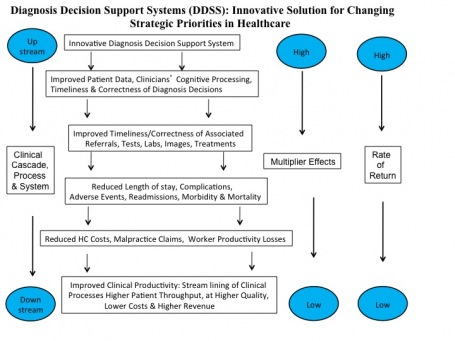- Privacy Policy
- Terms & Conditions
- Contact us
- ©Isabel Healthcare 2025
Diagnosis Decision Support Tools Help Optimize Productivity
Whether the debate is at the national healthcare reform level or down at the level of a specific episode of care for a certain patient, a large part of the discussion about how to deal with the many ills of the US healthcare situation has focused on cutting back on benefits or care covered and/or requiring patients to pay more for their care. In this discussion we have paid much less attention to a third broad, equally or even more important approach – improving the way we deliver care or improving the productivity of our clinical delivery systems.
Called process improvement/re-engineering in other industries, it is high time that the healthcare industry began to think strategically about improving the clinical productivity of its processes and care delivery approaches, and re-allocate resources in a way that supports this new strategic thrust. Various estimates indicate that we could wring out about a third of the total $2.5 trillion the US spends annually on healthcare through quality improvements that increase clinical productivity.
Further, we believe that if you look across the clinical process at various possibilities for improving clinical productivity, the biggest clinical and financial benefits will come if we first make improvements to the upstream clinical inputs that drive the decisions that produce downstream clinical outputs/outcomes – as other industries have done. And the three most seminal, initiating of these upstream clinical inputs are the quality of patient data, the quality of the cognitive processing clinicians carryout on/with that patient data, and the resulting quality of the diagnosis decision for a given patient – that is the speed, completeness and accuracy of the diagnosis decision.
In turn, if the diagnosis decision is wrong, every clinical decision downstream of that diagnosis decision will be wrong, wasteful and harmful – e.g. referral decisions, decisions about labs, tests, images, treatments, which will cause unnecessary complications, adverse events, morbidity, mortality, readmissions, and related increases in healthcare, legal and worker productivity costs (i.e. lost days of work).
To date, most of the healthcare industry’s attempts to improve quality have gone to downstream activities such as figuring out what outcomes to measure, going out and measuring those outcomes, EBM, bringing in CPOE system to cut down on treatment errors, etc. While these have been worthwhile investments, a number of recent studies on quality strongly suggest that over the last ten years quality has not improved that much and may have even declined.
Given the key initiating upstream position of diagnosis decision making, doesn’t it make sense for the healthcare industry to consider reallocating more of its quality/clinical productivity improvement efforts into systems that help clinicians improve their diagnosis decision making? If these diagnosis decision support systems (DDSS) could reduce diagnosis errors by 10%, their total clinical and financial benefit and ROI across a given episode of care would be a multiple of this 10% because most of the downstream clinical mistakes and costs associated with the upstream diagnosis error which would be avoided.

Because of this large positive multiplier effect across and down the entire clinical cascade of a given episode of care, we believe that investments in DDSS may generate a far higher clinical and financial ROI than most other attempts to improve quality and clinical productivity. Furthermore, by preventing these downstream clinical “speed bumps,” “do-overs,” delays, harm and costs, DDSS can streamline clinical workflows and processes, enabling clinicians and their clinical systems to operate more productively – e.g. serve more patients at a higher quality and lower cost per episode of care, which in turn will grow the top revenue line and gross margin line of the healthcare organizations for which these clinicians work.
~~ George Reigeluth, VP Isabel Healthcare
Subscribe Here!
Recent Posts
Isabel DDx Companion with ChatGPT Integration - to help you diagnose even faster
At Isabel Healthcare, we’ve always been driven by one goal: to make clinical reasoning faster,..Virtual Triage: Do more questions lead to better patient outcomes?
One of the common misconceptions related to virtual triage / symptom checker tools is that the more..List Of Categories
- Differential Diagnosis Decision Support
- Differential diagnosis
- Symptom Checker
- Symptoms
- Medical Error
- Patient Disease Information
- Disease
- Clinical Decision Support
- Diagnostic Decision Support
- Isabel 1 Minute Read
- Diagnosis Error
- Diagnosis Skills Cases
- Healthcare Informatics
- Clinical Reasoning
- Evidence-based Medicine
- Medical Education
- Patient Engagement
- Symptom Triage
- Nurse Practitioner Education
- Nursing Decision Support
- Partnership
- Public Health
- COVID-19
- EHR
- Patient Empowerment
- Patient Safety
- rare disease

Start your FREE Trial today
Try the Isabel Pro DDx generator for 30-days - no payment card details required.



